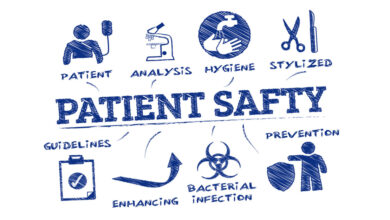UAE Ministry of Health: Leading on Automation in Outpatient Medication Dispensing
UAE Ministry of Health:
Leading on Automation in Outpatient Medication Dispensing

Dr. Abdalla Ahmed Alnaqbi. MD. United Arab Emirates, Ministry of Health and Prevention.
Dr. Amin El-Shamy. PhD researcher in Health Economics, MSc in Health Economics, MPA, B Pharm, Health Technology Assessment Office, United Arab Emirates, Ministry of Health and Prevention.
James Waterson. RN, M.Med.Ed. Associate Member, Infusion Nurses Society.
An article submitted to the American journal of hospital pharmacy long ago in 1967 identified how ‘outpatient visits are increasing at a rapid rate and administrative adjustments will be needed to handle larger outpatient prescription volumes’. The author laid out how, ‘new methods and procedures must be developed to reduce patient waiting time, provide the physician and the pharmacist with information pertinent to drug therapy and increase productivity through the elimination of administrative detail which can be handled better through automation’.1
The situation remains not dissimilar in 2019, some fifty-two years later. Outpatient visits continue to rise year-on-year, with increasingly complex patients being handled by these departments. Globally there has been a drive towards automation in healthcare to help handle the constantly increasing workload, and to allow for the redeployment of our limited numbers of highly qualified staff away from routine tasks and towards more constructive engagement with patients. There is also considerable political and financial pressure on healthcare decision-makers to optimize the utilization of resources and to improve services for patients, whilst ensuring that any automation and technology that is deployed definitively adds quantifiable health-economic value. The size of any initial investment in health technology and automation is inevitably significant and requires substantial decisions to be taken about funding, the need for change, and required re-engineering of a facility’s infrastructure and established hospital and department procedures, policies and workflows. 2
The remit of the Health Technology Assessment Office to the UAE Ministry of Health and Prevention (MOHAP) is to act as a guide on the introduction of new Health Technology to MOHAP in an efficient, equitable, transparent and explicit manner. The priority of the office is the welfare of the UAE’s population and to act always with the highest economic, ethical, legal, social and organizational standards regarding patient care.
With the above in mind, the Health Technology Assessment Office embarked on a two-site head-to-head comparison between an automated and a ‘traditional’ outpatient pharmacy to assess possible cost-benefits of extending pharmacy automation across multiple MOHAP outpatient facilities in the UAE. Output from an automated outpatient hospital pharmacy hospital and the conventionally managed outpatient pharmacy of a hospital acting as a control was collected over 12 months. During this period 11,646 patients were served by the traditional pharmacy with 33,782 prescriptions and 12,739 patients were served by the automated pharmacy with 37,754 prescriptions. See Table 1.
Metrics collected from both pharmacies were average time from prescription order to dispensing, completeness of medications dispensed versus prescriptions, expired inventory, average inventory stock levels, turnaround of unused or uncollected medications into circulation, number of mislabelling or prescription discrepancy events caught, time taken in completing regular inventory, and percentage of missing medications identified.
The study took place over 12 months in 2018. The automated pharmacy served 9.4% more patients than the traditional pharmacy in this period and dispensed 11.8% more prescriptions. Overall the automated pharmacy showed a 28.8% lead over the traditional unit in correctly dispensed prescriptions. The time to fill a received prescription was also an impressive 95.7% less than in the traditional pharmacy. Maximum turnaround times for dispensed complete prescriptions was also reduced by 81.4%. The improvement in the number of completely filled prescriptions was perhaps partly due to the increased numbers of individual medication types that the automated pharmacy can store. These increased to 114,262 individual medication types, up 1.3% from the 112,814 held in the traditional pharmacy’s storage. This is not an uncommon finding in automated pharmacies; robots are simply better than humans at mundane tasks like constantly calculating the optimum way of stacking and placing medications on shelves, this ensures that more items can be stored without increasing the overall volume of stock. Up to 4,000 medication packs/metre of shelving can be stored by advanced robotic systems. Pharmacy robots even use ‘down-time’, when they are not dispensing or adding stock, making minute adjustments to existing stock on shelves and cleaning the storage area. An increase in line-item storage without a concurrent growth in stock level overall would generally be responsible for less bound capital, the reduction of expired stock loss, and a higher value to the organisation in the stock held as more prescriptions could be serviced and completed.

When adding stock pharmacy robots can also read expiry dates on drug packages, and thereby reduce waste from out of date medications, and also automatically recognise medications that require refrigeration. Some automated pharmacies have internal refrigerated storage units within them and their entire stock area is temperature controlled.
The large increase in speed of dispensing by the automated pharmacy seen in the head-to-head study is probably due to the nature of ‘picking’ by the pharmacy robot; rapid barcode identification of ordered medications and multi-picking of up to 8 medication packages per move makes for a speedy pick up and conveyor belts and automated gates leading to spiral chutes can deliver these picked medications directly to the patient service point. Regular inventory is a labour-heavy task in a manual pharmacy. Automated pharmacies can maintain a consistent inventory count as each of the actions, direct loading into the robotic-managed storage with barcode reading for medication stock-up and automatic item deduction from stock level upon dispensing is under its control. This means that the inventory balance is a constant and dynamic process.
From what has been seen in this head-to-head study the time savings and accuracy of automated dispensing for outpatients are both impressive. Further efficiencies are perhaps also possible if workflow bottlenecks, such as that between prescription and the commencement of dispensing can be resolved. Studies generally seem to indicate that the fuller the integration between systems such as Computerised Practitioner Order Entry, Electronic Medication Administration Record, and the patient’s Electronic Medical Record and automated dispensing systems the greater the gains for the organisation.
Table 1: 2018 results for each pharmacy.

Our experience of automation, integration and e-prescribing in our MOH pharmacy can also be seen here:
“Experience automated pharmacy technologies LIVE with BD at Arab Health Hall 3, booth S3/D50. BD, advancing the world of health.”

References.
1. Hynniman C and Lamy P. Outpatient pharmacy automation. American Journal of Hospital Pharmacy 1967; 24. 18-21.
2. Sng Y, Ong C, Lai Y. Approaches to Outpatient Pharmacy Automation: A Systematic Review European Journal of Hospital Pharmacy 2019; 26:157-162.
















